Reprinted with exclusive permission of Camera Shopper magazine and the author himself
www.camera-shopper.com
The Soviet camera industry produced some very fine miniature cameras and lenses. But there is considerable confusion regarding Russian counterfeit Leica cameras. Hopefully, this article will help clear the air. In its early years many Russian designs were copies of the Leica II, and for good reason. This camera incorporated a built inrangefinder and a collapsing lens and a focal plane shutter. It was a revolutionary design incorporating quality construction, advanced features all in a small size.

Counterfeit 1931 Luxus with wood panels. Original had black leather covering
Initially, in 1932, two factories produced Russian copies of the Leica II: The VOOMP experimental factory, which later became known as GOMZ and even later as LOMO (Leningrad Optical and Mechanical Union) manufactured a Leica copy named Pioneer. In 1934 manufacturing operations were transferred to the firm Zavod Geodesiya that produced the Foto Apparat Geodezia or FAG cameras. Despite ambitious plans, only a small number of cameras were produced in these workshops, and eventually, FED in Kharkov produced the large bulk of Russian Leica copies. Most counterfeit Leica II cameras are remanu-factured pre-war FED cameras. In terms of quality, the Pioneer and the FED left much to be desired. Metal work and machining were poor and while the Industrar 10 lens was a copy of the Elmar, it was of lesser quality. Still, there was every reason to expect better cameras in the future.
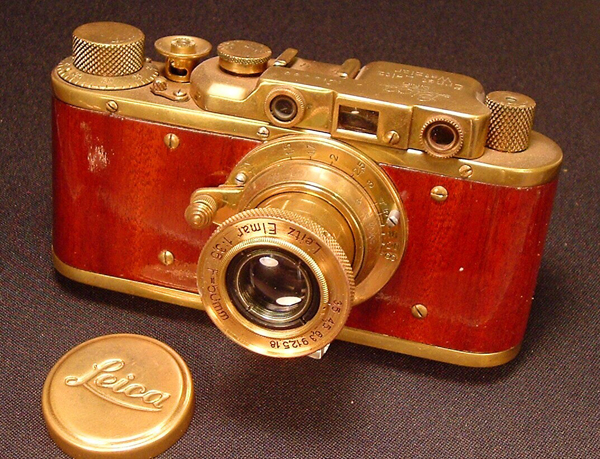
Counterfiet Leica II with wood panels. Original had black leather covering.
Neither the Pioneer nor the FED was a counterfeit Leica because neither used the name Leica or Elmar or claimed to be produced in Germany by Ernest Leitz. They were probably in violation of German copyright laws but the new socialist republic disregarded such legal niceties. Russian copies were much like many post war Japanese copies such as the Nicca, Chiyoka, Tanack, Canon or even the British copy made by Reid.
Altogether, some 300 different cameras have been inspired by or copied Leica miniature cameras. Unlike these postwar English and Japanese copies, which were often very high quality, the early Russian copies were of poorer quality.
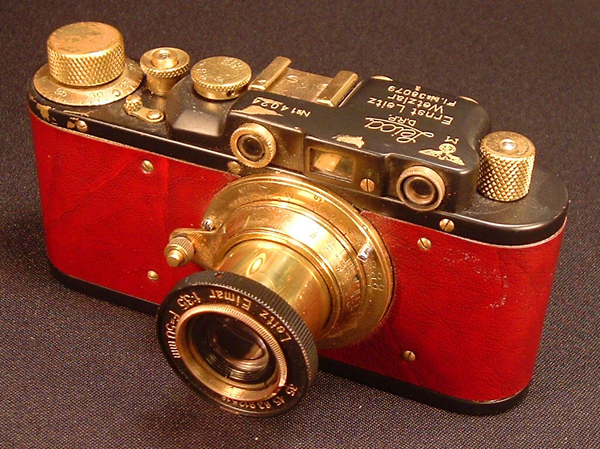
A second counterfeit Leica II with leather covering.
After the Second World War, FED cameras were again manufactured. And, from about 1950 a new camera of very similar design appeared. Without getting too complicated, there were even Fed Zorkis in 1948. The prewar Fed (i.e.- Leica II) design was still manufactured by Topographical Service of the Air Force after under the name TSVVS, but in very small number.

A third counterfeit Leica II.
In addition to this, from 1946, Kiev cameras were manufactured in the Zavod Arsenal factory. These cameras, faithful duplicates of the pre-war Contax II and Contax III, were previously manufactured in Germany. Indeed, the original German plants were disassembled, transported to the east where they were reassembled. This plant eventually produced copies of the Minolta 16, the Hasselblad 1000, the Minox EL among others, and these Kiev cameras remain in active use all over the world.

A really gaudy counterfeit Leica II.
By 1951 the Russian camera industry was far more sophisticated. A new FED 2 represented a new design and these cameras were also named Zorki 2, Zorki 3, and Mir. Curiously, Zorki quality was often better than the original FED design, if only because improved manufacturing procedure led to better quality control. FED camera were largely cobbled together by hand where Zorki production, while not auto- mated, was subject to an assembly line. Optics were also better after the war and many amateur photographers found that a complete set of lenses and a Zorki 4 body and finder cost them less than a real Leica and produced very respectable results. Indeed, the Zorki 4 became quite popular and from 1956 to 1973 over 1.75 million cameras were manufactured along with a special Commemorative Zorki 4 in 1973.
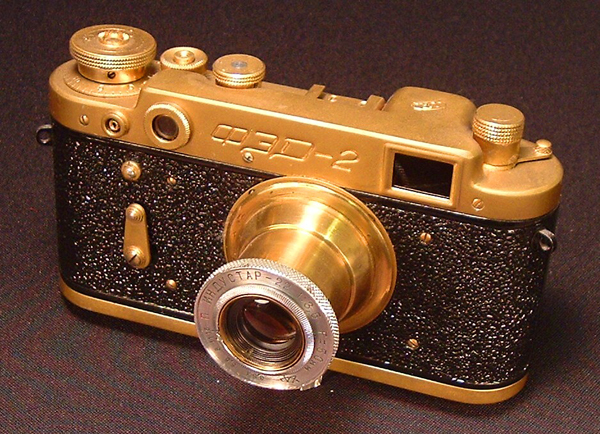
Post War Fed II
Russian 35mm cameras were cheap, sometimes pretty good, often dreadful, but they were never counterfeit Leicas any more than the Canon IVS2 was a counterfeit Leica. The Kiev produced in the Soviet Union may not have been the equal of the prewar Contax II, but it was not named Contax and the cameras were not marked made in Germany. This changed when the Soviet Union collapsed and the Russian economy went into free fall.
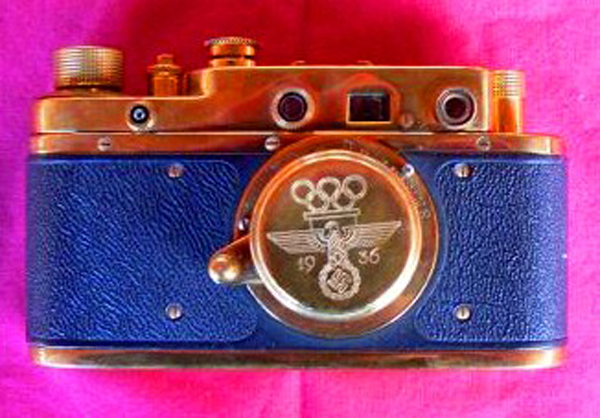
Another post war Zorki, with blue leather and markings from 1936.
With a worthless ruble, many re-manufacturers attempted to convert prewar or wartime FED cameras into counterfeit gold colored Leica II cameras. Similarly, the Elmar inspired Industrar 10 lenses reappeared, in gold colored form, now bearing the name Elmar. Curiously, no gold copies of the Kiev/ Contax line have appeared.
In fact, these new cameras were counterfeit in more than just name. The bright shiny finish was less often a gold wash, and never gold plated or gold filled, but usually a highly polished and lacquered brass finish.
Still, the camera sometimes looked pretty good, if not genuine Leica quality. In the process of re-manufacturing some of these cameras actually improved in terms of functional quality. Many were torn down and reassembled to better quality than the original camera. I had one counterfeit that produced truly excellent images. It is fair to conclude, however, that gold colored FED cameras were made and sold for their cosmetic value more than their picture taking ability.
Why would anyone think these were true gold Leica cameras? It is likely that almost no one did though every now and then someone who seems genuinely naïve offers a counterfeit for sale. The original German Leitz plant itself, curiously, started the original confusion of what is a counterfeit and what is not.
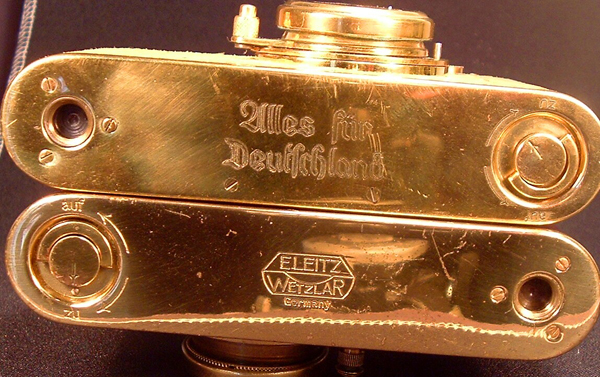
Bottom plates of counterfeit Leicas.
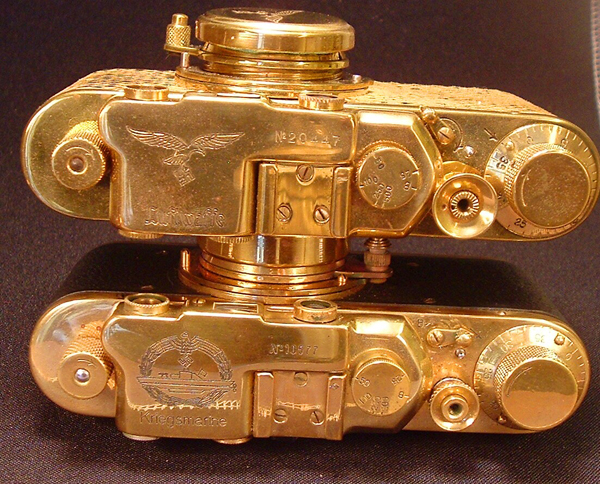
Top plates of counterfeit Leicas.
Before the war, the truly novel Leica I of 1925-30 caught the imagination of photographers and quickly became a status symbol for the rich and for celebrities. In order to cater to these famous and wealthy patrons, Leica produced a small number, perhaps 95, of gold Luxus versions of the Leica I in 1929-30. Several additional Luxus cameras were manufactured in 1931 but the factory did not keep records of how many they produced for those who had purchased standard versions of the camera, and returned their cameras to the factory for gold plating and reassembly.
I wonder if Ernest Leitz did not consider this some sort of folly that would probably pass in time. Unfortunately, the number of genuine gold plated Luxus Leicas was soon increased by an unknown number of counterfeits. Even less is known about the number of these or where they were produced, but the numbers were large enough to create a market in gold plated Luxus cameras, and their duplicates. Unlike subsequent gold colored Fed cameras, the quality of the duplicate Standard Luxus version can be very good indeed.
When counterfeiters introduced gold colored FED cameras with Leica II markings after the collapse of the Soviet Union, the numbers were small at first. No doubt, these small workshops, like Ernest Leitz himself, thought this would prove to be a self-limiting enterprise. After all, how many counterfeit gold Leica cameras could be sold? Similar entrepreneurs brought us counterfeit John Player Special KGB cigarette pack cameras because there had been KGB use of cigarette pack cameras.
These went through a small production run though they still come up on eBay from time to time. One small shop even produced a gold Notebook camera based upon the same Kiev 16 used in the John Player Special. It is not a bad looking piece but there is no way to actually load the camera hidden within the outer leather covering.
And yet, rather than decreasing in sales, as almost anyone would have expected, these counterfeits have actually found a small niche in the camera market. Russian vendors continue to sell them to someone. If they did not sell, they would not be on the market. In order to amplify their alleged genuine design, Russian counterfeit Leicas come with a variety of different markings. There are special Kreigsmarine versions, special Luftwaffe versions, as well as allegedly real versions of the Leica cameras produced for the 1936 Olympics. All of these versions come with the proper markings, even when the alleged original itself often may not have existed in actual fact. As an example, the German army and navy did use Leica cameras made with special cold weather shutters and with bolstered lens mounts. These cameras were often colored with a very durable industrial gray finish. I doubt many front line officers were issued gold plated cameras.
The funniest counterfeit Leicas are gold colored Zorki cameras. The Zorki, unlike the Fed, remained in active production after the war, and was not produced before the war. Hence, there is the funny situation of a lovely blue-sided post war gold colored Zorki camera with 1936 Olympic markings. Similarly, other Zorkis bear special Luftwaffe and Kreigsmarine wartime Nazi insignia markings. This is like renaming a Ford Pinto as a Model A and selling it as such.
But the situation is still a little more clouded. Not every gold colored Russian 35mm camera is a counterfeit Leica II. The logic is peculiar but someone has also produced gold colored Fed II cameras as well as later Fed models. Perhaps this workshop was able to change the metal coating but not the engraving. Even the commemorative Zorki of 1973 did not appear in a gold version.
Even more confusing, there is at least one genuine Russian gold colored camera, the Fed Micron half frame camera, a copy of the Konica Eye 2 camera manufactured in 1967. The example presented here is the only one I have seen and I have no idea why or when it was produced. None of this would have been possible without the phenomenon of eBay. Auction houses would not sell obvious counterfeits without labeling them as such and individual dealers would have recognized these cameras as obvious fakes. But eBay made it possible to sell Russian gold counterfeit cameras in the West with little interference. In its early years, Russian vendors simply called their wares gold Leica II cameras. Later, after considerable confusion, vendors were forced to list their wares as imitation or copies or use any other term to indicate that this is not a real Leica. Some very coy vendors have even noted that while they think this is a real Leica; it is possible that it may be a copy if it comes from Russia or Ukraine, hedge your bets.
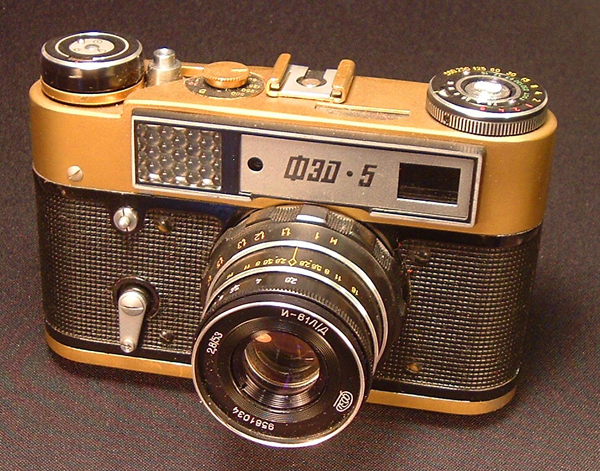
Gold Fed 5. Counterfeit?
So there you have it. Russian gold cameras are almost always phony duplicates of the pre-war Leica II. Sometimes they are gold colored versions of standard Russian FED cameras, Zorki cameras and, in perhaps one case, there is a legitimate actual gold colored camera, the Fed Micron Half Frame. If you are curious about how to tell a counterfeit from the real thing, you can see the top plate of both in one of the pictures. Not only is there a visible difference in the machining and engraving, the shutter button is totally different. Every counterfeit Leica I have seen has a flared shutter shield.
I do not know of anyone with a truly comprehensive collection of Russian gold colored counterfeit models. I am not even sure that the few represent more than a small part of the full spectrum of what has been produced. Even more, I am not sure why the heck I have them at all.
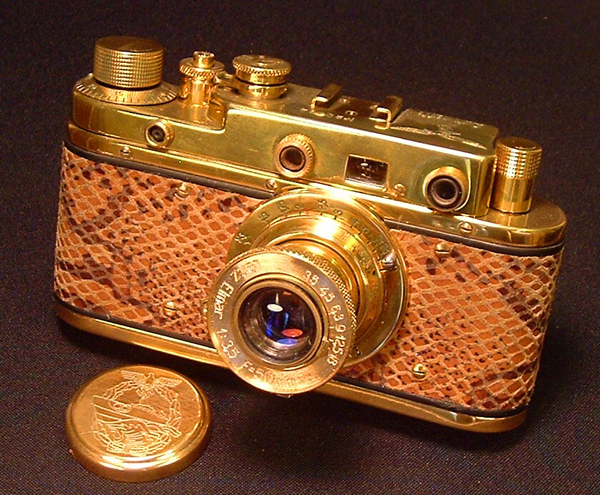
A post war Zorki with snakeskin and wartime markings.
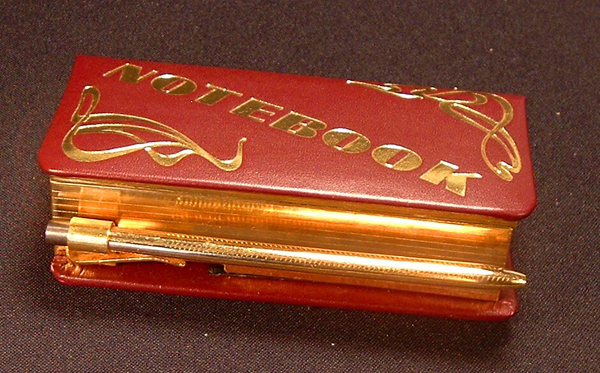
Notebook camera spine with cutout for lens.
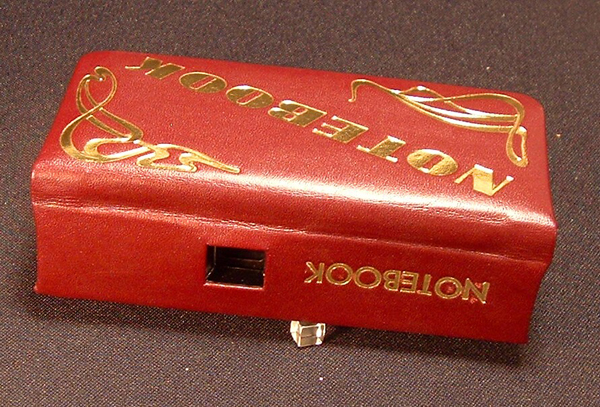
Notebook camera top. Did a real one ever exist?
When I began to collect gold cameras, I decided not to collect these particular gold counterfeits. But, as I was often able to pick up such cameras for less than $50, I figured why not? After all, many people collect Leica cameras and many other people collect Leica inspired cameras such as the Japanese Nicca and a wonderful book lists all 300 of the Leica copies. One could argue that Russian gold counterfeits constituted just one more, perhaps humorous, category of Leica collecting. If you do not think these counterfeits are worthy of collection, I can understand that too.
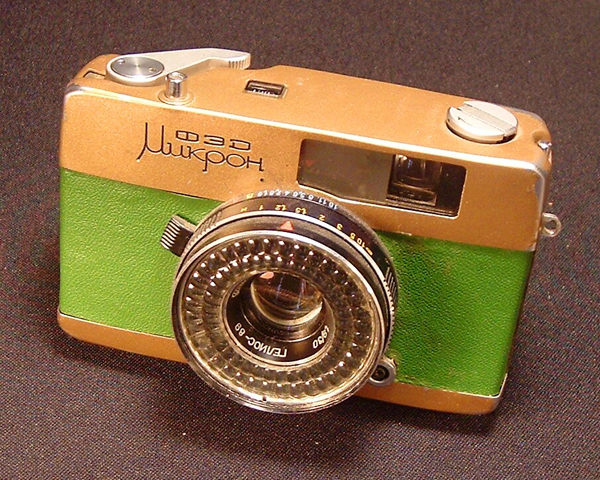
Fed Micron. Gold consists of a thin covering.
The best source of information for Russian photographica is Jean Loup Princelle's The Authentic Guide to Russian and Soviet Cameras Made in the USSR. And for pictures and information about more Leica copies then you knew existed; see Patrice-Herve Pont & Jean-Loup Princelle, Three Hundred Leica Copies. Wanna buy a gold Leica?
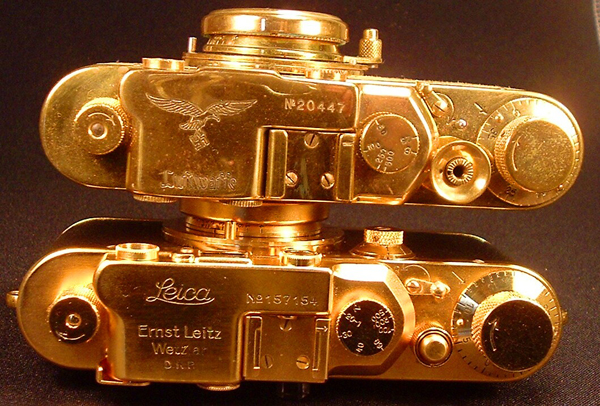
Comparison of real gold Leica top plate (bottom) and counterfeit on top.
See the difference in shutter button and machining of shutter speed dial.
Jerry Friedman can be contacted online at smallcameraco@yahoo.com © 2008 Jerry Friedman
© 2008 CameraShopper Magazine camera-shopper.com
